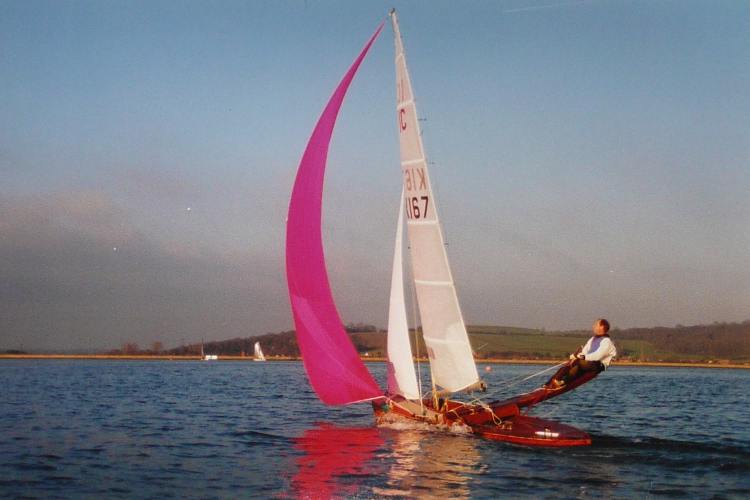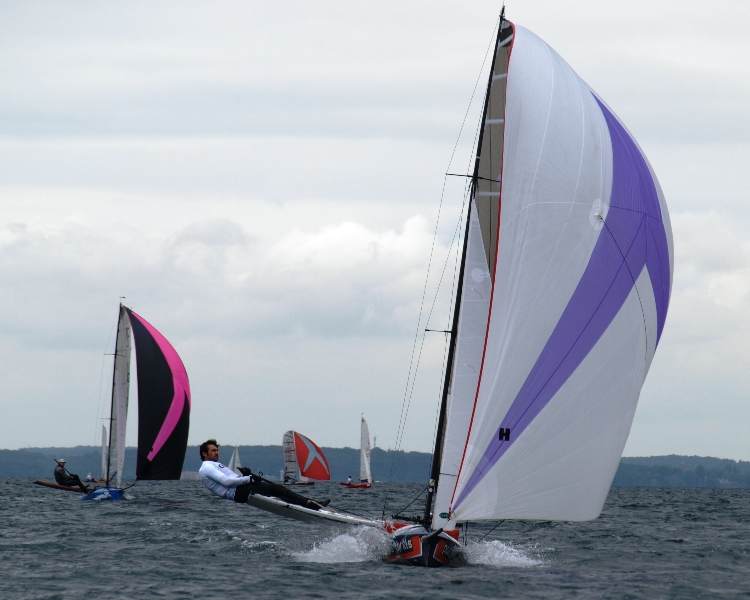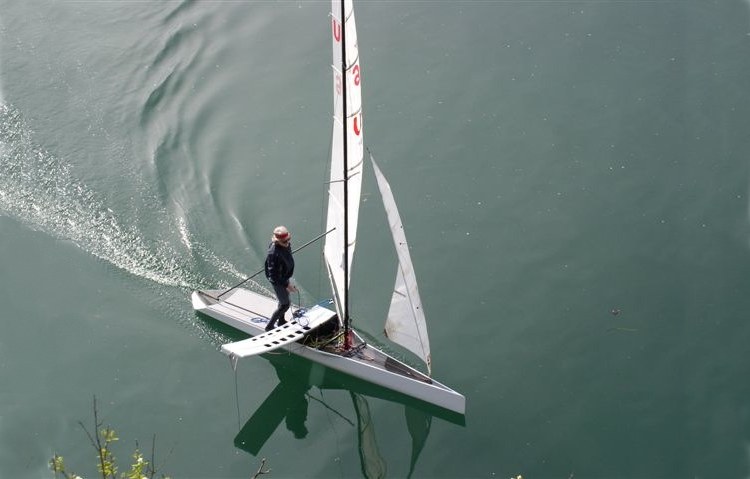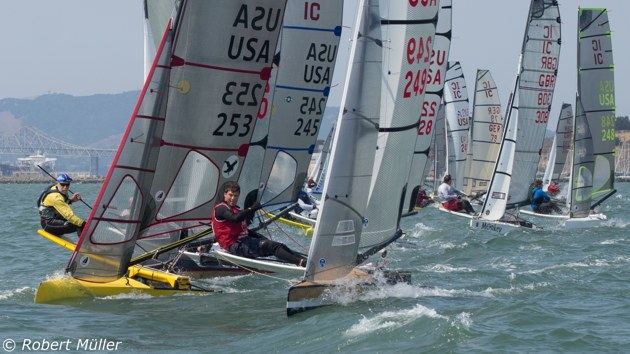Image: "The mountains of the Llyn Peninsula behind, and Brett Holly (AUS1) at the 2017 Worlds, Pwlhelli. Photo: © Robert Muller"

Simon Hotchin's 'Luna', one of the earliest AC Conversions.
©
Alan Powell.
Experiments began with fitting an asymmetric spinnaker to the IC in around 1991. The first experiments seem to have been made by John Shaw, with Simon Hotchin adding some more momentum by 1997. Rob Michael, Andy Gibbs and Phil Allan were much involved in the late 90s. The main development was led by Rob Michael of Razorback boats, who spent a considerable amount of time designing systems and setups before launching the first purpose built asymmetric boat, "Outlaw" in 1999. The most commonly fitted system for hoisting and dropping the kite fitted uses "pump" handles rather than a direct pull on the line. Its a very effective system when well maintained and has been influential on other classes: the RS700 being an obvious example. The initial sails were moderate in size - around 15sq.m., but the AC has evolved to use a very large spinnaker, often 20sqm or more, and tends to sail quite deep angles and is at its best on windward/leeward courses. The spinnaker equipped boats carry a large letter A near the mainsail clew, but continue to carry the IC logo in the normal place, and became known as "ACs".
The AC proved very popular in the UK, and in the first decade of the 21st century was sailed in greater numbers than the IC. However, perhaps due to the absence of Rob Michael's enthusiasm, committment and support, only a few were built in the other Canoe sailing countries.

AC in full flight. Arne Stahl, AC runner up at the 2011 Worlds.
© Robert Muller.
By 2008 it seemed that the AC was not destined to gain wide international acceptance. Building of spinnaker-free boats had somewhat stagnated though, and Steve Clark of the US introduced a proposal to return the rule set of the two sail boats to essentially that of 1934, but with a much lower minimum weight. The concept behind the chosen weight was that the 1934 limit was near but not at the limits of the technology of the time, so the new limit was set near but not at the limits possible in 2008. The proposed rule set was worked up in public with much international input, notably from Andy Paterson in the UK, who had been a key figure in developing the modern narrow International Moth. The revised rule set was adopted by the ICF in 2009.

String Theory. Winner of the Development class at the 2008 World
Championships. Showing the powerful stern and fine bow of this thread
of new rules design.
© Monique Maas.
Early developments saw a great variety of shapes, especially in the stern treatment, which varied from a wide and powerful stern hitting the limits of the rule to very fine moth like sterns. Other than that the general theme was for boats which are close to the limits of minimum waterline beam and much finer in the bows that previous generations of canoes. Its interesting that everyone seemed to building minimum beam boats. The one design Nethercott, in common with many UK designs, was not at the minimums of the rules prevailing when it was designed, and history seems to point to a number of occasions when wider boats were faster than narrow ones.
A few single sail boats were tried, but the mast height restriction seems to limit the effectiveness of such rigs. Andy Paterson built a very minimalist single sail boat which came out 40kg, 20% under the minimum weight limit which was important in establishing the credibility of the new limit. Another important influence was Phil Stevenson of Australia, like Paterson a Moth sailor and builder, who built a stressed/tortured ply boat which was also down to the minimum weight. His technique involves using expanded polystyrene foam internal bulkheads which do not create such extreme hard points as conventional timber framing.

Tin Teardrop. Andy Paterson's interpretation of the development rule.
This is Tin Teardrop version 1.2: version 1.0 had no shrouds at all
and version 1.1 had the shrouds on outriggers, which was felt to be
inappropriate and the rule wording was tweaked.
© Graham
Caws.
The new development boats first appeared at the 2007/8 world championships in Australia, where they raced in their own class. The 2011 World championship was the first event where new designs raced for the main medals. Chris Maas, from West Coast USA, won both the development class in 2008 and the full World Championship in 2011. His Canoe designs had a powerful stern to the limits of the rule. Other prominent designers at the time of writing are Steve Clarke in the US, and Alistair Warren and professional designer Phil Morrison in the UK in the UK.

Colin Brown's Morrison 1, GBR 319 Sky. Winner of the 2013 Europa Cup.
One of the more moderate new rules designs.
© Jim Champ.
© Jim Champ/International Canoe Federation 2012/5
Many contributors to the International Canoe Forum
Personal experience and private emails: I had some involvement in the discussions around the proposed new rule set.
'Sliding Seat' UK newsletter 1999-2001, especially Rob Michael's contributions.
Simon Hotchin's archives.
This web site is provided by the International Canoe Federation's Sailing Committee
Image: "Just about the most dramatic IC photo I've ever seen. Emma Grigull (GER65) at the 2017 Worlds, Pwlhelli. Photo: © Robert Muller"
Image: "Uphill Challenge: Peter Ullmann (GER79) leads a bunch of others at the 2011 worlds, Travemunde, Germany. Photo: © Robert Muller"


Image: 2014 Worlds, San Francisco. Race 4 Start line action. Chris Maas and Willy Clark battling at the pin end. Photo © Robert Muller